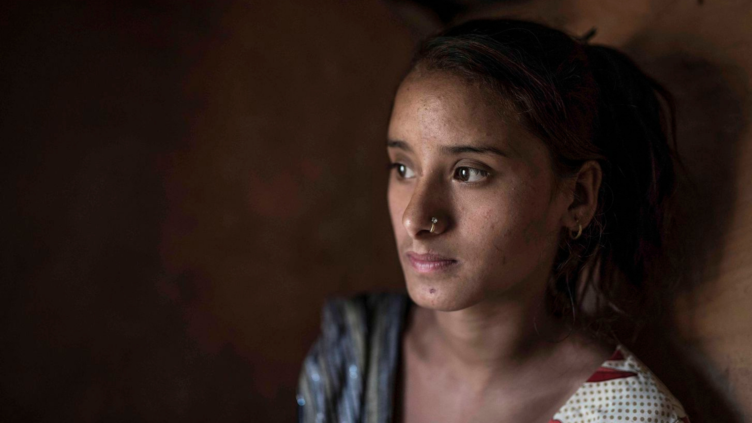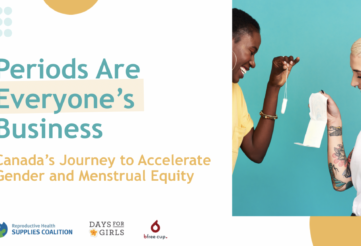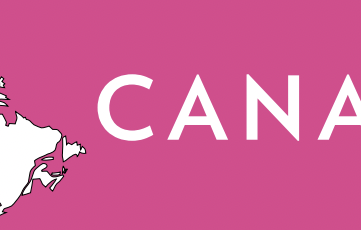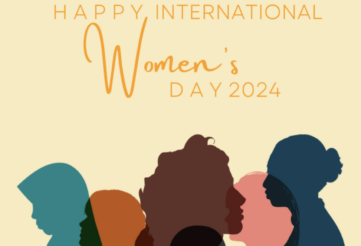Building Bridges to End Gender-Based Violence: How Prevention and Menstrual Equity Go Hand in Hand

Each year, thousands participate in 16 Days of Activism Against Gender-Based Violence, a campaign hosted by UN Women to raise awareness and catalyze action to end violence against women and girls. Harkening to the campaign’s signature color, this year’s theme is “Orange the world: End violence against women now!”
Over the past year and a half, the COVID-19 pandemic has reinforced gendered factors that are connected to incidence of gender-based violence (GBV), contributing to its increase.
As discussed by UNFPA’s COVID-19 impact brief, the pandemic has exacerbated some of the foremost contributors to GBV including unemployment, poverty, gender stereotypes and harmful social norms. These same conditions impact the ability of women and girls to manage their menstruation with dignity. Traditionally, menstruation is rarely recognized as a trigger for GBV. However, in many communities, menstrual stigma, taboo, and some harmful traditional practices are linked to instances of violence towards women and girls.
If we are to eradicate GBV we must also cultivate and strengthen supportive MH environments for women and girls.
Economic Turmoil and GBV
Outside of the health sector, economic turmoil was one of the foremost impacts of the pandemic.
In June 2020, UNDP estimated 40-60 million people would be pushed into extreme poverty due to the economic shock of COVID-19. The same socioeconomic impact assessment estimated that 1.6 billion individuals lost 60% of their typical income over the course of 2020. These global economic stressors trickle down to impact menstruating individuals, as poverty and unemployment place women and girls at risk for a gendered form of economic violence specifically tied to menstrual cycles. This occurs when funds used to purchase menstrual solutions are withheld by a patriarch, partner or parent, or when these individuals lack understanding of why menstrual products should be considered essential.
The same lack of understanding may lead husbands or partners to inflict physical violence on female family members, who may need to repurpose fabrics in the home (such as blankets) to use as a makeshift menstrual solution when they cannot afford or access products. Days for Girls (DfG) Uganda Country Director, Diana Nampeera, has observed that when men leave cash for their wives to purchase food and essentials and women reallocate some of those funds towards menstrual products, they may be beaten or abused as a result.
In addition to disrupted income, the pandemic impacted global commodity prices. In Plan International’s report on Periods in a Pandemic, respondents from Lebanon, Zimbabwe, Zambia and Bangladesh all discuss how the pandemic has caused an increase in the price of MH products in their communities. Astoundingly, communities in Lebanon experienced a 500% increase in the price of menstrual products. Those rising prices, alongside levels of extreme poverty, increased risk for economic forms of GBV during the pandemic as families weighed the costs of which items to deem essential.
The WASH Factor
Another impact of the pandemic was a decrease in access to safe WASH facilities for women and girls due to lockdown, which is an essential component of both menstrual health and GBV protection. When people with periods do not have access to clean, private, and safe sanitation facilities, they may be followed, seen inappropriately, or violated. Physical, psychological and sexual violence are all directly reduced by a safe sanitation facility.4
Prior to COVID-19, women and girls often accessed safe sanitation facilities at schools and community centers, but the closing of these facilities during pandemic shutdowns has impacted their safety. Unfortunately, this risk tends to impact those who are already vulnerable: in a Menstrual Hygiene Day 2020 Webinar hosted by DfG, DfG Lebanon Program Coordinator, Khayrieh Al Assaad shared that lack of quality WASH facilities in refugee camps are a major barrier to menstrual health and safety for women and girl refugees. Often, WASH facilities in refugee camps are located far from housing and lack privacy, gender-separation, lighting at night, and modes for proper disposal of used products.
Declining Social Safety Nets
Third, COVID-19 has disrupted the social safety nets that often protect women from GBV.
Prior to the pandemic, one study in India suggested that close-knit communities like villages provide monitoring of private issues such as husbands demanding sex during their wives’ menstrual cycles (which is culturally forbidden). However, the study found that when families moved to the city in search of work, due to economic pressures, they often landed in informal settlements.
The change in social groups loosened community relations and allowed husbands to request “sex on demand” from their wives more frequently, leading to quarrels among couples that may end in violence. As COVID-19 and immigration crises have disrupted the fabric of communities over the past two years, women and girls may find themselves lacking social protection and at higher risk of GBV.
Child Marriages: A Growing Problem
One of the final intersectional effects that the pandemic has had on GBV and MH is the issue of child marriage.
UNICEF estimates that due to COVID-19, 10 million additional girls are now at risk of child marriage. Malawi’s First Lady, Monica Chakwera, discussed in her speech on International Day of the Girl, in October 2020, that child marriage had increased by nearly 300% in 7 districts. Conditions such as pregnancy, parental deaths, school closures and economic stress have all contributed to this upward trend.
Musu Bakoto Sawo shares in her personal narrative of life in The Gambia that there, menarche determines a girl’s marriageable status and is perceived as an indicator of marriage readiness. As a very young woman, Sawo was placed in a position where sexual relations with her husband were expected and it was culturally unacceptable for her to refuse, exposing her to sexual violence. For many low-income families, early marriage of a daughter is often viewed as a way to improve the financial security of the family through dowry, or as a last resort to shift the financial burden of provision (including provision of menstrual products) to her new husband.3 Navigating these difficult financial choices can place girls into early marriage, where they may be at higher risk for GBV.
On the whole, the COVID-19 pandemic has highlighted the strong interconnectedness of menstrual health needs and triggers for gender-based violence. Economic volatility, restricted access to public goods like WASH facilities, shifting social groups, and the stressors felt by individual families, have all impacted both the menstrual health and protection of women and girls globally. MH is an issue intricately tied to GBV, and cannot be overlooked in GBV prevention efforts.
As the world seeks to address GBV during the 16 Days of Activism campaign, inclusion of MH is absolutely essential for promoting a safer and more equitable world where women and girls can pursue opportunities and reach their full potential.
By: Elena Steinhaus MA, DfG Advocacy Volunteer
Citations
Bakoto Sawo, M. (2020). Personal Narrative: Let Girls Be Girls – My Journey into Forced Womanhood. In The Palgrave Handbook of Critical Menstruation Studies (pp. 93–97). essay, Palgrave Macmillian.
Chakwera, M. (2020, Oct. 9). International Day of the Girl [Speech]. International Day of the Girl, Lilongwe, Malawi.
Maharaj, T. (2020). Transnational Engagements: Cultural and Religious Practices Related to Menstruation. In I. T. Winkler (Ed.), The Palgrave Handbook of Critical Menstruation Studies (pp. 163–174). essay, Palgrave Macmillian.
McCarthy, A., & Lahiri-Dutt, K. (2020). Bleeding in Public? Rethinking Narratives of Menstrual Management from Delhi's Slums. In The Palgrave Handbook of Critical Menstruation Studies (pp. 15–30). essay, Palgrave Macmillan.
Patkar, A. (2020). Policy and Practice Pathways to Addressing Menstrual Stigma and Discrimination. In The Palgrave Handbook of Critical Menstruation Studies (pp. 485–509). essay, Palgrave Macmillan.
Plan International. (2020). Periods in a Pandemic. https://plan-international.org/publications/periods-in-a-pandemic#download-options
UNICEF. (2021, March 7). 10 million additional girls at risk of child marriage due to COVID-19. Unicef.org. Retrieved 2021, from https://www.unicef.org/press-releases/10-million-additional-girls-risk-child-marriage-due-covid-19.
The United Nations Development Programme. (2020). Putting the UN Framework for Socio-Economic Response to COVID-19 into Action: Insights. https://www.undp.org/coronavirus/socio-economic-impact-covid-19
The United Nations Fund for Population Activities. (2020). Impact of the COVID-19 Pandemic on Family Planning and Ending Gender-based Violence, Female Genital Mutilation and Child Marriage. https://www.unfpa.org/sites/default/files/resource-pdf/COVID-19_impact_brief_for_UNFPA_24_April_2020_1.pdf
Barkawi, B. (2020). Period Poverty Rises in Lebanon as Price of Sanitary Products Skyrocket 500%. Thompson Reuters Foundation, Global Citizen. https://www.globalcitizen.org/en/content/period-poverty-on-the-rise-lebanon-covid-19/
WoMena. (2020). WOMENA FAQ: What are the links between menstrual health management (MHM) and gender-based violence (GBV)?. https://womena.dk/wp-content/uploads/2020/06/FAQ-GBV-and-MHM-14JUNE-2.pdf









